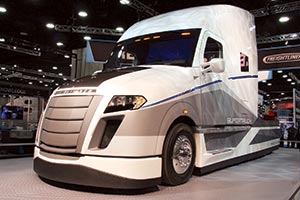Senior Reporter
Truck OEMs Tout Their SuperTruck Improvements

NASHVILLE, Tenn. — Truck makers said they continue to reap huge benefits from the SuperTruck program, adding significant technology advances to their production models.
In an update session at American Trucking Associations’ Technology & Maintenance Council annual meeting here, all four major truck original equipment manufacturers said they have met or exceeded the goals of the first phase of the SuperTruck program as they continue their research in SuperTruck II.
Since its launch in 2010, the SuperTruck program has had two major statistical goals — increase freight efficiency by 50% over a 2009 baseline model for the first SuperTruck program and by 100% over the same base for SuperTruck II.
SuperTruck II projects will place an emphasis on technology cost-effectiveness and performance.
Achieving Class 8 truck efficiency increases will require an integrated systems approach to ensure that the various components of the vehicle work together.
SuperTruck II projects will utilize a wide variety of truck and trailer technology approaches to achieve performance targets, such as improvements in engine efficiency, drivetrain efficiency, aerodynamic drag, tire rolling resistance and vehicle weight.
But already the SuperTruck program has produced a variety of technologies in demonstration vehicles that are reaching the market.
The SuperTruck program, equally funded by industry partners and the U.S. Department of Energy, is comprised of not only truck makers, but also suppliers who have all been drilling down on Class 8 subsystems, aerodynamics, and engine and materials to improve freight efficiency.
On display at the TMC March 2 exhibition and podium session were production trucks from Volvo Trucks North America, Daimler Trucks North America’s Freightliner unit, Peterbilt Motors Co./Cummins Inc., along with Navistar’s project truck, said Ken Howden, director of DOE’s 21st Century Truck Partnership.
The overal goal of the SuperTruck program is to accelerate introduction of Class 8 truck technologies that use less fuel, increase fuel diversity, operate more safely, are more reliable, meet future emissions standards and are cost effective.
On display were production models of Freightliner, Peterbilt/Cummins Inc., Volvo and Navistar’s innovative SuperTruck demonstration vehicle, CatalIST.
All four truck original equipment manufacturers’ project teams have exceeded the first phase freight efficiency goals.
“Really this was not about a demonstration vehicle as much as it was advancing technology to put into vehicle production, said Ken Damon, manager of vehicle performance for Peterbilt.
Peterbilt was the first to meet all the goals of the program, showing efficiency gains of 76% in the drive cycle and 86% in a 24-hour cycle, Damon said.
Peterbilt also was able to reduce the weight of trailers by 1,300 pounds, Damon said.
In 2014, Peterbilt launched its aerodynamic improvements, and in 2015 offered its predictive cruise control that uses GPS to look ahead at the approaching terrain to automatically adjust speeds, Damon said. Since then, the truck manufacturer has also launced a lighter front axle and a lighter composite brake drum assembly.
Also, when compared to the 2009 baseline model, engine downspeed at 65 miles per hour has decreased considerably, from in the 1,400-1,500s rpm to the 1,100s,” said Vivek Sujan, a Cummins engineer. “And we can see in the future it’s going even further down.”
Daimler’s Jeff Girbach, manager of engine technologies, agreed that the Freightliner’s SuperTruck also is capitalizing on high-risk, high-reward, research to ultimately bring significant improvements to company production models.
“These programs grow into large partnerships with national labs, universities and all of the suppliers that contribute to a lot of our current trucks, partnering up with us to develop these exciting technologies,” Girbach said. “What we’re trying to do in these partnerships is create the most efficient Class 8 truck in the world.”
Girbach said Freightliner achieved a 115% improvement in vehicle freight efficiency with the final demonstrator, 18% of which came from light weighting.
“Our original baseline vehicle was 34,000 pounds, we dropped that to 31,200 pounds,” Girbach said.
Charles Chilton, Navistar’s director of product development, said the company’s SuperTruck team worked on 40 different technical areas, achieving many results similar to the other OEMs.
The Navistar truck achieved a freight efficiency improvement of 104% and has reached 13 miles per gallon. The vehicle also has demonstrated 50.5% brake thermal efficiency.
“It’s the first class 8 highway tractor that changes shape driving down the highway,” Chilton said. “At low speeds we will change the height of the vehicle for curbs and docking situations.”
“We have not yet given up,” he added. “We’re right now in the beginning phases of SuperTruck II phase, where we will to continue to improve the engine’s freight efficiency and provide commercially viable solutions that meet the simple payback equation, which in our world is about one to two years in terms of benefit to our customers.”
Last fall, Volvo unveiled its version of SuperTruck with it’s modified VNL 670 highway tractor demonstrating an 88% gain in freight efficiency and an extra 70% in fuel economy.
In model year 2016, Volvo VNL introduced a revised bumper with air flow underneath that combined with trailer aerodynamic fairings on it, about 0.5% to 0.7% increase in fuel economy, said Wade Long, Volvo’s director of product marketing.
“But we continue to refine and make improvements to that truck,” Long said.

